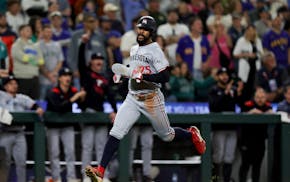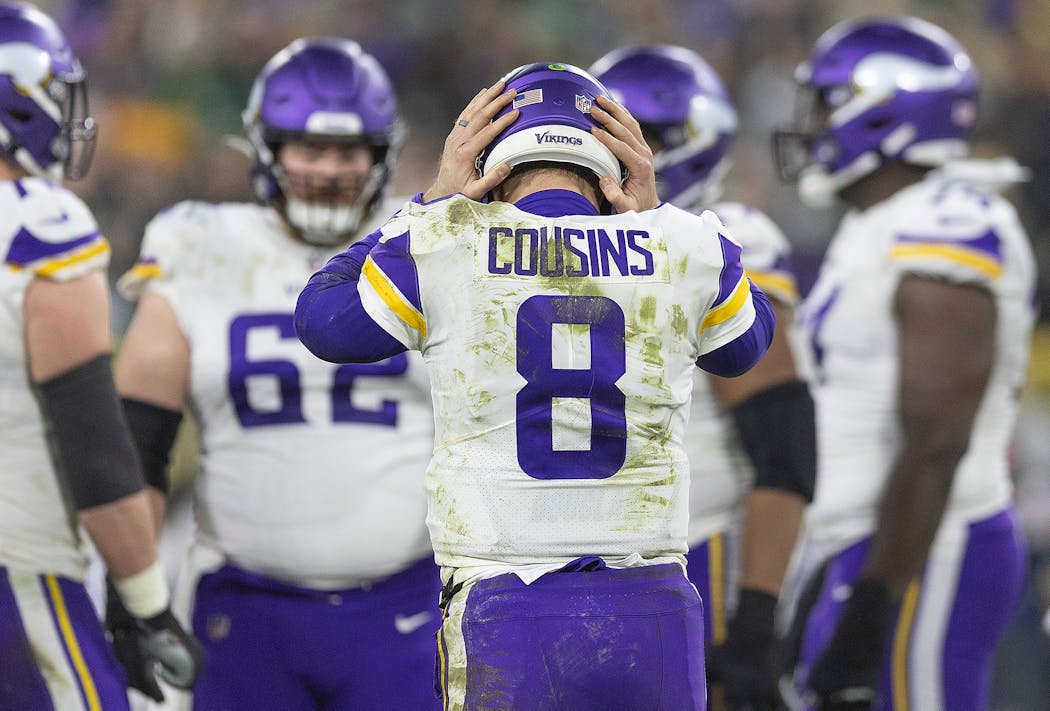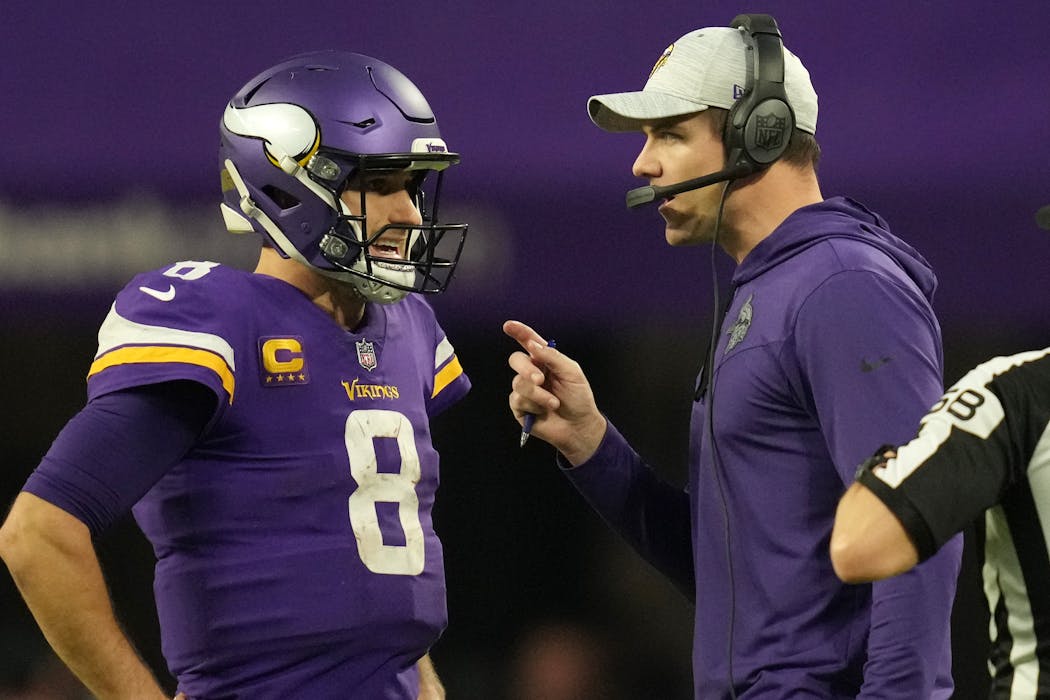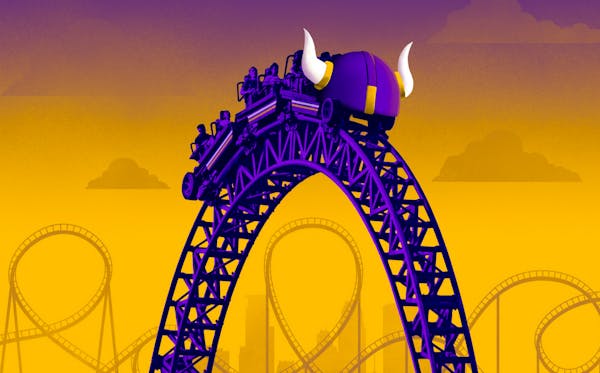The play clock resets to 40 seconds, and the NFL's production machine whirs to life, filling dead time with another serving of what just happened. Stadium video boards show replays of the previous play; color commentators analyze and opine for the audience at home.
As the machine makes entertainment out of the recent past, those directing offenses write their futures.
"Between the previous play ending and the next play starting, there's a lot that happens at the quarterback position, the coaching position, that many times defines your career," Vikings quarterback Kirk Cousins said.
The empowerment Cousins has felt during Kevin O'Connell's first season as Vikings coach turns into a critical on-field trust in the 40 seconds between snaps, where the two men direct a scheme that's only grown more complex for the quarterback in the five years since they last worked together in Washington. Cousins said he has more responsibility at the line of scrimmage this year than in any of his first 10 in the NFL, adding, "It's felt like I'm cramming for a final exam every single week of the season."
O'Connell made Cousins one of his first phone calls after he became the Vikings coach in February, letting the quarterback know how much the offense would demand of him and how strongly he believed Cousins could handle it. While Cousins threw more interceptions (14) and had a lower quarterback rating (92.5) than in any of his eight seasons as a full-time starter, he threw for the second-most yards of his career, led a league-high eight game-winning drives and reached his fourth Pro Bowl. The Vikings open the playoffs Sunday against the Giants after winning their first NFC North title with Cousins at quarterback.
"It's given us a real edge to be able to prepare in a way where he's got total ownership," O'Connell said, "but then, his ability to adapt and adjust right along with me as the play-caller has been huge."
Years of defensive coordinators and offensive play-callers making their schemes tougher to solve have turned the 40 seconds between snaps into a frantic cryptology effort, with quarterbacks playing the role of both encoder and decoder.
From 0:40 to 0:15 on the play clock, O'Connell can talk to Cousins, who sometimes cups his hands over his ears to block out the crowd noise threatening to drown out O'Connell's next play call. Backup QB Nick Mullens said some third-down calls, with adjustments built in for pressure packages, are 15 to 20 words long; wide receiver Justin Jefferson said the lengthiest calls take 10 seconds to deliver.
Many calls in the Vikings' scheme are actually two plays in one, with directions for Cousins to "can" the first play to get the offense out of a bad situation or into a better one.
O'Connell gave a theoretical example of a medium-length Vikings play call: "Z Short Fleece Rt Taco 74 Barracuda Switch Y Bench Burst [a pass play], can to 50 Smash H Riot [another pass play]."
Wide receiver Adam Thielen provided another: "Let's just say, 'Gun Weak Right Ace 17 Wanda [a run play], can to F Coco Bow [a pass play].' " He added: "We do have some code words where he can 'can' it to a code word. But there's times where it's a full play call, canned to a full play call. So there's a lot of words in there. And in this offense, if you say one word wrong, it changes the entire concept of the play. So those details are unbelievable."
O'Connell's voice cuts out at 0:15. Cousins heads to the line, often using motions or hard counts that might change the offense's leverage or bait a defender into giving up his disguise. Cousins surveys the defense one last time, making any last-second calls to alter the Vikings' protection scheme or the details of a play, and shouts, "Turbo, set" to call for the snap.
How often does Cousins change something from O'Connell's initial play call by the time the ball is snapped? "I would probably say close to 70 percent," O'Connell said.
"It could be a run to a run, a run to a pass, changing directions. But yeah, it's a lot," he added. "You watch the higher-level offenses, and you just hear it — 'Can! Can! Kill! Kill!' — just all the ways you try to have a plan for the best possible play versus the look you get."
Cousins speaks warmly of how O'Connell has backed him as the team's leader, while O'Connell praises the quarterback's careful attention to his role as an on-field lieutenant. Both are fathers in their mid-30s whose families are close. They meet for two hours the day before each Vikings game to go through O'Connell's call sheet, but their game-plan discussions often start earlier in the week, over 10 p.m. texts once their kids are asleep.
"We've scored on plays this year that either Kirk suggested, or a big third-down conversion he had ultimate ownership of," O'Connell said. "I think the big thing for him this year is, his ownership has just grown by leaps and bounds, with his comfort and what we're asking of him."
Getting to know your QB
O'Connell's four years as an NFL quarterback give him insight into the complexities of Cousins' job. He has also been a champion for the quarterback at a time when the Vikings' on-field success has provided Cousins, 34, room to show more of his personality than he had done during his first four years with the team.
So frequently caricatured as a dorky dad, Cousins has laughed along with the joke through most of the Vikings' 13-win season, telling stories in his news conferences about his neighbor who clears the snow from his driveway; his wife, Julie, picking out his clothes; or his Holland, Mich., dentist scrambling to make custom grills for Cousins to match Jefferson's.
After some loopy late-night humor led to Cousins wearing left tackle Christian Darrisaw's bejeweled chain on the team's Oct. 2 flight back from London, the quarterback wore thousands of dollars' worth of teammates' jewelry — and a tucked-in T-shirt — on the victorious Vikings' flight home from Miami on Oct. 15. His "Kirko Chainz" alter ego hit its peak on the way home from Washington on Nov. 7, when teammates' video of Cousins dancing shirtless in chains and blue-blocker sunglasses quickly went viral.
Before the season, Cousins said he didn't think Minnesotans knew him very well; now, he says, "We're closer."
None of it would have happened if the Vikings weren't winning, he concedes. But the victories, and a coach quick to celebrate Cousins' role in them, gave all of it a boost.
O'Connell frequently names Cousins as the chief reason for the Vikings' success, inviting him to break down the team's huddle after victories. One of the coach's other favorite methods of backing the quarterback is putting teammates on the spot by trading places.
"Sometimes, it's a simple thing, like at a walkthrough or a practice, calling a play into him and then looking over at J.J. or Dalvin [Cook], saying, 'Hey, call that one,' " O'Connell said. "They're looking at me like, 'Absolutely not.' "
Other times, O'Connell will call up a clip of Cousins standing in the pocket and taking a hit while delivering a critical third-down strike. "I want everybody on our team and our coaching staff to know that — maybe not the granular details of it, but just the circumstance," O'Connell said. "The respect he's garnered from his teammates, if I can help in any way [to] make that a reality and make it what it should be, it's my job as the head coach."
Articulating to teammates the unique pressures of his job, Cousins said, is probably the most meaningful way O'Connell has empowered him. The clips O'Connell picks are also part of his gentle nudge for Cousins to play more boldly; the balls Cousins fires into tight windows while bracing for contact have won him a legion of supporters in the locker room.
Jefferson blasted Cousins' critics on Dec. 29, posting on Twitter that "all of the Kirk criticism has to stop!!" and suggesting those who mock the quarterback do so because they "hate his dad swag." The tweet came five days after the Vikings' victory over the Giants on Dec. 24, when Cousins made a third-down throw to Jefferson with 1:14 to go that showcased all of his talents to right tackle Brian O'Neill.
"I hope everybody else is starting to see it," O'Neill said. "The one where he checked to a different protection: four seconds left [on the play clock], called the right combination, got the ball off real quick, stood in there and delivered a dart. I mean, that's big-time."
Creating something special
Validation strong enough to squelch Cousins' critics might not arrive without consistent playoff success, which could also realize his hopes of finishing his career in Minnesota with O'Connell. To make a run through the NFC playoffs, where Cousins is 1-3 in his career, the Vikings will have to solve a field that includes four teams among the NFL's best in quarterback pressure rate, with O'Neill out for the season and center Garrett Bradbury returning from a back injury.
They will also have to deal with what O'Connell calls "the JJ effect," where teams are so preoccupied with slowing down Jefferson that they abandon coverage tendencies. O'Connell said the Vikings have gone into multiple games against opponents that play single-safety coverage 60-70% of the time, only to see them spend almost the entire day with two safeties deep and one shaded toward Jefferson.
Cousins and O'Connell discuss how to leverage opponents' attention on Jefferson, and ways to spring the All-Pro receiver, knowing they might have to recreate their plans.
"His willingness to sometimes allow me to create something, and his comfort level and trust, knowing what we're trying to do, has been huge," O'Connell said.
Jefferson said some of his biggest catches this season came when Cousins saw a favorable matchup and checked him to a vertical route. Hockenson said the complexity of the Vikings offense, and Cousins' ability to manipulate all of it at the line of scrimmage, is what keeps them from running out of answers when defenses focus on Jefferson.
"It doesn't just lock you into one single play call," said Hockenson, who arrived from the Lions in Week 9 and became one of the Vikings' franchise-record four receivers with at least 60 catches this season. "Now, you have a full-field concept that's really good against the whole thing. It puts everybody eligible to receive the ball at all times in this offense, which is huge."
All the relationship-building between O'Connell and Cousins, all the talk of empowerment, is mostly to buttress a connection that has to hold up in those 40 seconds between plays.
Most of the world will never hear their exchanges. Unless, perhaps, the production machine grabs one for a highlight package after an unforgettable playoff moment.
"Even when the play is not changing, his thought process might change when the ball hits his hands. So it's a lot," O'Connell said. "I do think it ultimately is the best way to function if your quarterback can handle it. And he's proven time and time again that he can."

Twins rally against Mariners with three last-chance runs and a bunch more in the 10th

Playing without their star, Lynx keep things perfect with comeback at Phoenix

Buxton returns to top of Twins lineup and to his post in center field




